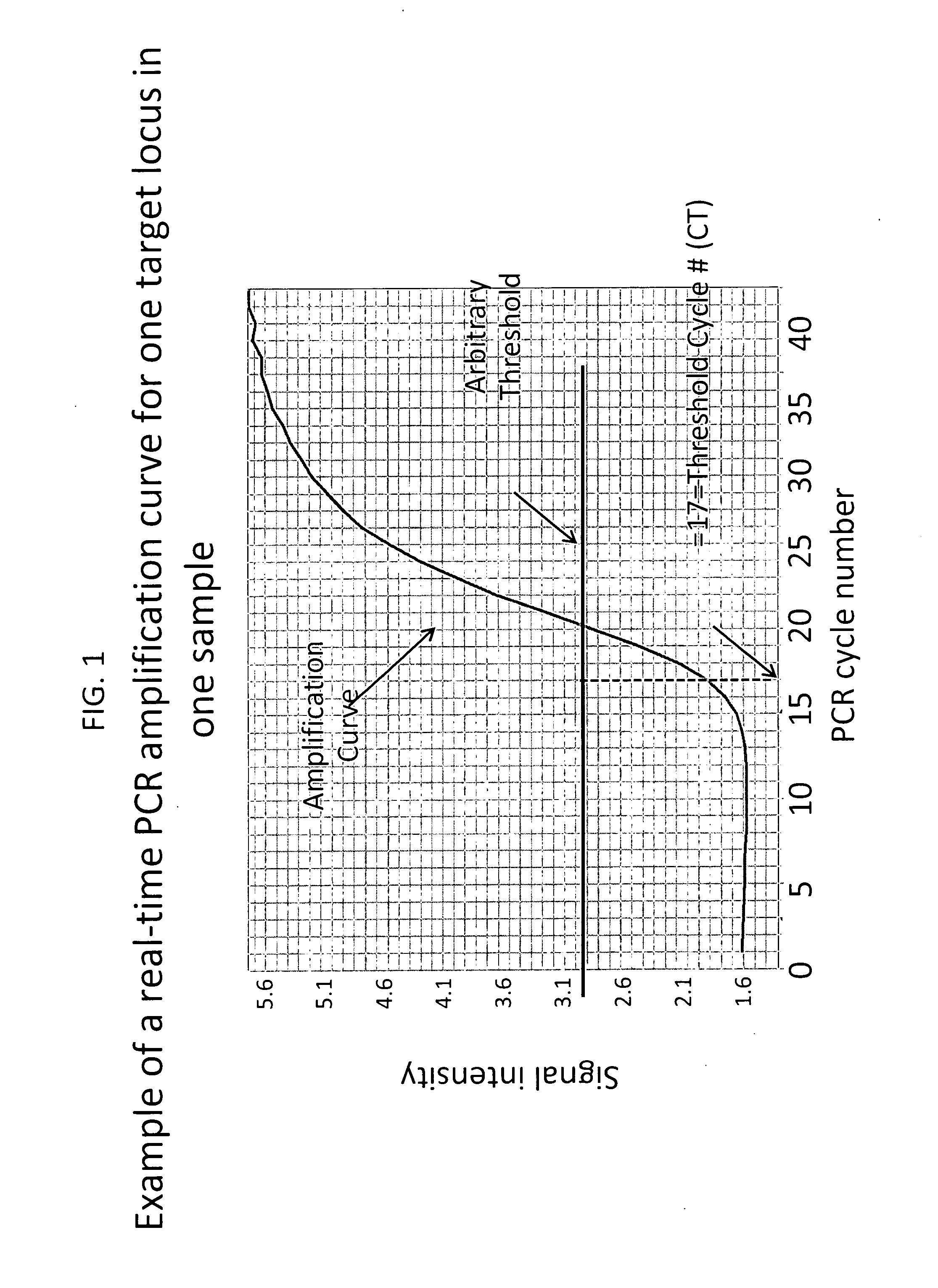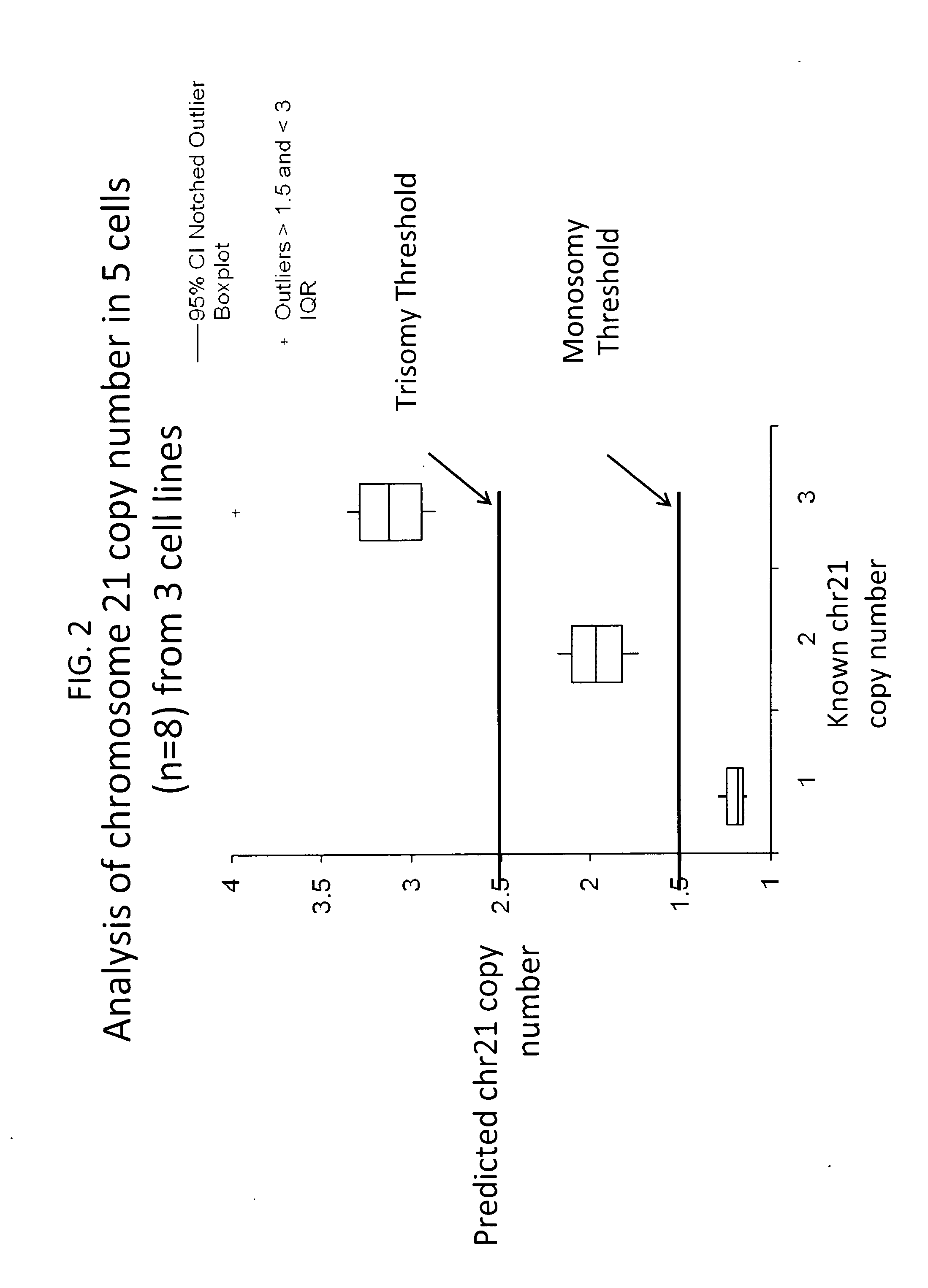Method for relative quantitation of chromosomal DNA copy number in single or few cells
a chromosomal dna and copy number technology, applied in the field of relative quantitation of chromosomal dna copy number in single or few cells, can solve the problems of reducing the possibility of a high-risk multiple pregnancy and greater chance of implantation
- Summary
- Abstract
- Description
- Claims
- Application Information
AI Technical Summary
Benefits of technology
Problems solved by technology
Method used
Image
Examples
example 1
Identification of Invariant Loci and Analysis of Chromosome 13 Copy Number in Cell Lines and Embryonic Tissue using Real-Time PCR and 2−ΔΔCT Analyses
[0113]Genetic loci suitable for predicting chromosomal copy number according to the methods of the present invention (”invariant loci“) were identified by assaying the ability of loci to accurately predict the correct chromosomal copy number of cells of known karyotype (Coriell Cell Repository, Camden, NJ) (Table 3) and cells from frozen aneuploid embryos (Table 4).
[0114]In this example we established a set of loci for chromosome 13 that perform well. To do this, we obtained cells from cell lines and embryos that were previously determined to be either 46,XX (GM00321, Table 3), 47,XY,+13 (GMO2948, Table 3), or 45,XY,−13 (embryo 8, Table 4).
[0115]For the analysis of copy number of chromosome 13 in the given samples, 8 invariant loci (as FAM labeled assays) were selected based on commercial availability and design specific for exon detect...
example 2
Copy Number Assignment for 24 Chromosomes in a Trisomy 21 Female (47, XX +21)
[0123]Employing the methods of the present invention using the 96 loci indicated in Table 7 (FAM assays), accurate copy number was able to be detected for all 24 chromosomes in an aneuploid cell line obtained from a trisomy 21 female (47, XX +21) (Coriell ID AG16777). In this experiment, 5 cells were lysed in alkaline lysis buffer, preamplified with 96 target loci assays (Table 7 FAM assays), and preamplified DNA was then loaded in quadruplicate into a Fluidigm BioMark RealTime PCR 96.96 Gene Expression Array according to the manufacturer's instructions (Fludigm Inc.) and using Gene Expression Master Mix (ABI). Normal female samples were run in parallel and the chromosome copy numbers were calculated as described here. Data are depicted herein in FIG. 4.
example 3
PGD of an IVF Embryo may be Performed Using Invariant Loci and Real-time PCR and 2−ΔΔCT Analyses
[0124]It is contemplated that the invariant loci described in the Examples and Table 7 provided herein, as well as additional invariant loci that may be identified as disclosed, may be used to detect chromosome copy number in an IVF embryo using real-time PCR and 2−ΔΔCT analyses as outlined below:
[0125]As contemplated herein, embryos for PGD could undergo trophectoderm (TE) biopsy in the morning of day 5 or day 6 post-fertilization. A TE biopsy may be performed by conventional methods involving placing individual blastocysts into HTF-Hepes media (InVitro Care, Inc., Frederick, Md.) and opening a 5-10 μm hole in the zona pellucida, e.g., with a series of 1-3 single pulses from an infrared 1.48 μm diode laser utilizing a 1 millisecond single pulse duration at 100% power (Hamilton-Thorne Research, Beverly, Mass.). Herniating TE cells would then be aspirated into a trophectoderm biopsy pipett...
PUM
| Property | Measurement | Unit |
|---|---|---|
| volume | aaaaa | aaaaa |
| genetic defect | aaaaa | aaaaa |
| time | aaaaa | aaaaa |
Abstract
Description
Claims
Application Information
 Login to View More
Login to View More - R&D
- Intellectual Property
- Life Sciences
- Materials
- Tech Scout
- Unparalleled Data Quality
- Higher Quality Content
- 60% Fewer Hallucinations
Browse by: Latest US Patents, China's latest patents, Technical Efficacy Thesaurus, Application Domain, Technology Topic, Popular Technical Reports.
© 2025 PatSnap. All rights reserved.Legal|Privacy policy|Modern Slavery Act Transparency Statement|Sitemap|About US| Contact US: help@patsnap.com



